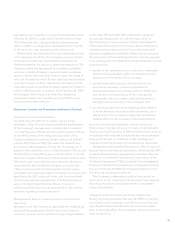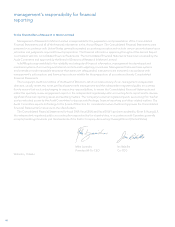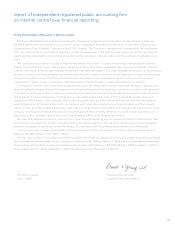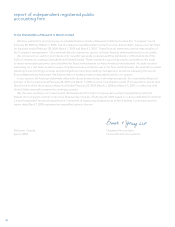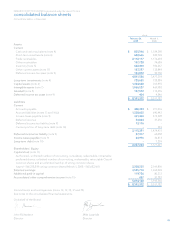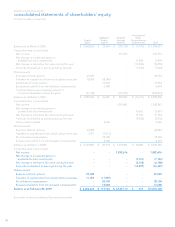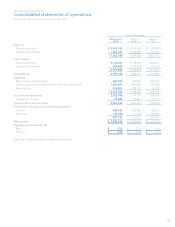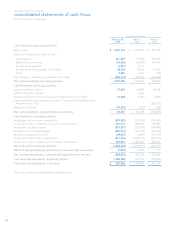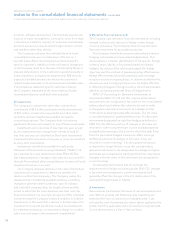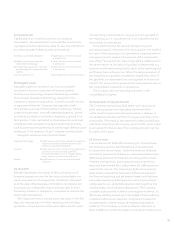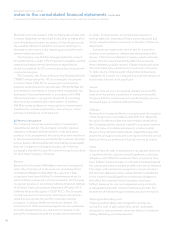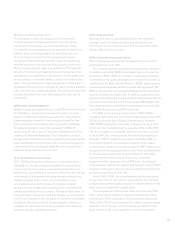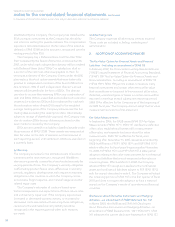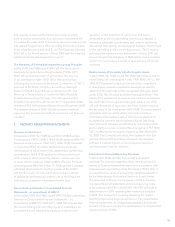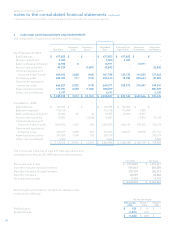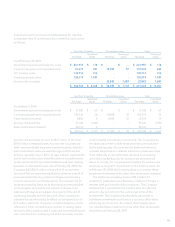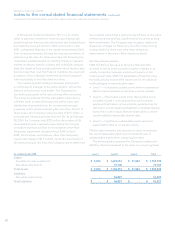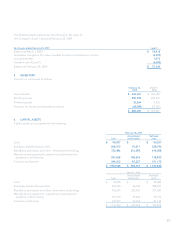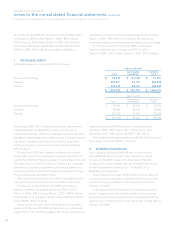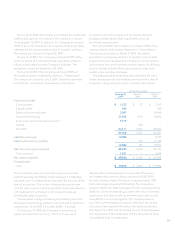Blackberry 2009 Annual Report Download - page 57
Download and view the complete annual report
Please find page 57 of the 2009 Blackberry annual report below. You can navigate through the pages in the report by either clicking on the pages listed below, or by using the keyword search tool below to find specific information within the annual report.
55
of a reporting unit exceeds its carrying amount, goodwill of
the reporting unit is considered not to be impaired, and the
second step is unnecessary.
In the event that the fair value of the reporting unit,
including goodwill, is less than the carrying value, the implied
fair value of the reporting unit’s goodwill is compared with its
carrying amount to measure the amount of the impairment
loss, if any. The implied fair value of goodwill is determined in
the same manner as the value of goodwill is determined in a
business combination using the fair value of the reporting unit
as if it were the purchase price. When the carrying amount of
the reporting unit goodwill exceeds the implied fair value of
the goodwill, an impairment loss is recognized in an amount
equal to the excess and is presented as a separate line item in
the consolidated statements of operations.
The Company has one reporting unit which is the
consolidated Company.
(n) Impairment of long-lived assets
The Company reviews long-lived assets such as property,
plant and equipment and intangible assets with finite
useful lives for impairment whenever events or changes in
circumstances indicate that the carrying amount may not be
recoverable. If the total of the expected undiscounted future
cash flows is less than the carrying amount of the asset, a loss
is recognized for the excess of the carrying amount over the
fair value of the asset.
(o) Income taxes
In accordance with SFAS 109 Accounting for Income Taxes,
the Company uses the liability method of tax allocation
to account for income taxes. Under this method, deferred
income tax assets and liabilities are determined based upon
differences between the financial reporting and tax bases
of assets and liabilities, and measured using enacted tax
rates and laws that will be in effect when the differences are
expected to reverse. The Company’s deferred income tax
asset balance represents temporary differences between
the financial reporting and tax basis of assets and liabilities,
including research and development costs and incentives,
capital assets, non-deductible reserves and operating loss
carryforwards, net of valuation allowances. The Company
considers both positive evidence and negative evidence, to
determine whether, based upon the weight of that evidence,
a valuation allowance is required. Judgment is required in
considering the relative impact of negative and positive
evidence. The Company records a valuation allowance to
reduce deferred income tax assets to the amount that is more
(k) Capital assets
Capital assets are stated at cost less accumulated
amortization. No amortization is provided for construction
in progress until the assets are ready for use. Amortization is
provided using the following rates and methods:
Buildings, leaseholds and other Straight-line over terms between
5 and 40 years
BlackBerry operations and other
information technology
Straight-line over terms between
3 and 5 years
Manufacturing equipment, research
and development equipment and
tooling
Straight-line over terms between
2 and 8 years
Furniture and fixtures Declining balance at 20% per annum
(l) Intangible assets
Intangible assets are stated at cost less accumulated
amortization and are comprised of licenses, patents
and acquired technology. Acquired technology consists
of purchased developed technology arising from the
Company’s corporate acquisitions. Licenses include licenses
or agreements that the Company has negotiated with
third parties upon use of third parties’ technology. Patents
comprise trademarks, internally developed patents, as well
as individual patents or portfolios of patents acquired from
third parties. Costs capitalized and subsequently amortized
include all costs necessary to acquire intellectual property,
such as patents and trademarks, as well as legal defense costs
arising out of the assertion of any Company-owned patents.
Intangible assets are amortized as follows:
Acquired technology Straight-line over 2 to 5 years except for acquired
in-process research and development costs
which is expensed immediately
Licenses Straight-line over terms of the license agreements
or on a per unit basis based upon the
anticipated number of units sold during the
terms, subject to a maximum of 5 years
Patents Straight-line over 17 years or over estimated
useful life
(m) Goodwill
Goodwill represents the excess of the purchase price of
business acquisitions over the fair value of identifiable net
assets acquired in such acquisitions. Goodwill is allocated
as at the date of the business combination. Goodwill is not
amortized, but is tested for impairment annually, or more
frequently if events or changes in circumstances indicate the
asset might be impaired.
The impairment test is carried out in two steps. In the first
step, the carrying amount of the reporting unit including
goodwill is compared with its fair value. When the fair value


